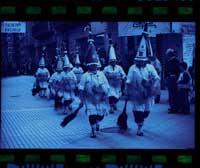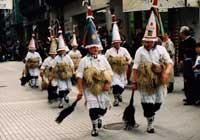Color photography (I): color film
Elhuyar Fundazioa
We have already talked about the film, specifically in number 88, without beginning to repeat the local from top to bottom, on its basis, we will analyze the peculiarities of the color film.
Before moving forward there are two main particularities: one is the presence of films in two ways (convertible or with slides and negative) and another is the adaptation of films to light sources (in natural or artificial light).

The positive image is revealed and formed directly by an emulsion placed in the light of the camera with a convertible film that produces slides (or transparencies). Slides can be viewed by a light source projecting it on a screen or surface or by a viewfinder. Most of these types of films can be revegetated at home, such as that of Ektachrome, Fujichrome and Agfacrome, while that of Kodachrome, due to the complex and secret development process it needs, must be revealed by the manufacturer itself.
The main advantages of the slide film are being able to reveal without special tools, get a unique color intensity and precision and be cheaper.
The negative film reveals the emulsion in the light of the camera and produces an image formed by negative tones and complementary colors. This is an intermediate step and to get a positive image it is necessary to make copies on paper. All negative colored films can be checked at home. As in black and white, they can be made positive on paper, but for this a laboratory is necessary. Unlike slides, by positivizing you can darken or lighten copies and you can also correct or change colors by filters. Colored paper copies do not require any kind of tool and you can make as many copies as you want from the negatives. For the photographer who wants many copies, the negative film is a good choice.
Both from the slides and from the negatives you can make copies in black and white and from the negatives you can make both slides and copies of the slides (when we talk about development we will be longer). The choice of a film does not close the way to other forms, but the best results will be achieved with a film prepared for it.

As for sensitivity, as in black and white, the faster the film, the more obvious (and less definition), and the more definition is achieved using the slower film left by light conditions.
On the other hand, from one brand to another, due to the different types of dyes, the colors are not reproduced in the same way and each one should choose depending on the results you want to obtain. Some films reproduce better the “hot” colors (red-yellow) and other “cold” colors (blue green).
Recalling the error of reciprocity (see photo in VIII; number 87), it is much more evident in color photographs, since at the same time that films lose sensitivity, contrast and density are lost and color deforms. Therefore, it is not advisable to use shutter speeds above 1 s and below 1/1000 s.
When measuring exposure (see photography in X and XI; numbers 89 and 90), it should be noted that slides have a latitude of exposure or contrast lower than films. In general, and especially in the slides, the calculation of the exhibition must be very precise if we do not want the color to be distinguished. Excessive and insufficient exposure has a different effect with slides or negatives. In general, slides accept insufficient exposure better than exaggerated exposure. In negatives it does not matter. Due to its greater latitude, the proper color density can be obtained by positivar. However, it is recommended to avoid insufficient exposure.
Color film structure
The color film is composed of three layers of black and white emulsion, placed on top of each other with great precision. Each of them is sensitive to a primary color (blue, green and red), from which the other colors are synthesized. The upper layer responds to blue, the central to green and the lower to red.
Under the blue is the yellow filter, whose function is to prevent the blue rays of light from passing to the other two and disappears in the development. The base and back are equal to those of black and white (see picture at no. 88). The four layers have a thickness of less than 0.001 mm and have the ability to reproduce all colors. All layers of neutral white and grey have the same answer. Negative films have a dark orange color due to the orange dye that lead to reduced contrast and greater color accuracy.

On the other hand, as indicated in the introduction, films should be adapted to the light source or, what is the same, to the color temperature of light day light (to the color temperature of light day light or to artificial lights). The so-called “white light” is a mixture of waves that covers all the colors of the spectrum. The composition of this mixture varies according to the light source. For example, the light of the candle has more red than the blue, in the shadows of the clean day, because of the light coming from the blue sky, predominates the blue... Each has its own color temperature expressed in Kelvin degrees.
If the film is used with a source of foreign light, color deviations occur (as in interiors, at sunrise and sunset, red predominates and blue outdoors). One of its solutions (if such a result is not desired), as mentioned in the filter article (Photo XIII; no. 92), is the use of corrective filters. Without taking into account when taking the photo, clogs can also be made in the laboratory with filters. But without forgetting that this serves for negatives, passing the slides through this process.





